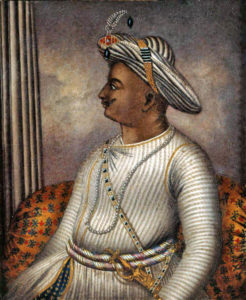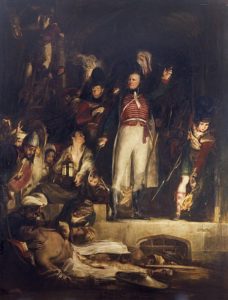By Pamela Toler (Regular Contributor)
In 1799, the Fourth Anglo-Mysore War came to an end when Major-General David Baird (1757-1829) led the final British assault on Seringapatam, the island citadel that served as a capital for Tipu Sultan, the self-proclaimed “Tiger of Mysore”.
Seen in retrospect, it is easy to forget how precarious Britain’s position in India was in the eighteenth century. The British East India Company was only one of several regional powers that competed to fill the power vacuum left by the disintegrating Moghul empire. One of the most powerful of the Company’s rivals was the Muslim state of Mysore in south-central India.
When the dynasty’s founder, Haider Ali, seized Mysore from its Hindu ruler in 1761, the British saw the new kingdom as a buffer against the powerful Nizam of Hyderabad. They soon changed their minds. Haider Ali and his son, Tipu Sultan, adopted two goals that put them in immediate conflict with the East India Company: aggressive territorial expansion and diplomatic ties with post-revolution France.
The East India Company’s rivalry with Mysore took on new urgency in 1798, when Napoleon Bonaparte invaded Egypt with the avowed intention of driving the British out of India. The possibility that France would attempt to reclaim a base in India seemed all too likely. British India buzzed with rumors that the French had joined forces with the Tiger of Mysore.
In February, 1799, those rumors were confirmed. British agents in Madras claimed to have intercepted a letter from Bonaparte to Tipu Sultan. In it, Britain’s number one enemy offered aid to his Indian counterpart, “Citoyen Tipou”: “You have already been informed of my arrival on the borders of the Red Sea with an innumerable and invincible Army, full of the desire of delivering you from the Iron yoke of England.” Scholars have long doubted the authenticity of the letter. Genuine or not, it provided the trigger that Richard Wellesley, the East India Company’s Governor-General, had been waiting for.
Forty thousand East India Company and Crown troops invaded Mysore on March 5th. The armies moved quickly across Mysore in a two-pronged pincer attack from the British strongholds of Madras in the east and Bombay in the west. Their goal was the fortified island citadel of Seringapatam.
On May 4, Major-General David Baird led the final charge against the walls of Seringapatam. According to his biographer, Theodore Hook, the general volunteered to lead the assault in order to “pay off old scores”. Volunteer or not, Baird was a sentimental favorite for the job. Twenty years early, he had spent four years as a captive of Tipu Sultan following the British defeat at Pollilur in 1780.
Once British cannons opened a breach in Seringapatam’s outer wall, Baird’s force crossed the surrounding river under a barrage of musket fire, fought their way into the gap, and took the ramparts. The main body of British and Indian forces followed. Two and a half hours later, Seringapatam was under British control.
That evening, Baird played the central role in another event that captured the British imagination. Acting on reports that Tipu Sultan had been killed in the assault, Baird sought out the Indian ruler’s body under a pile of corpses in a gateway that had been a focus of the Mysore defense. Major Alexander Beatson, official historian of the campaign, summed up the moment as seen through Victorian eyes:
“He who had left the palace in the morning a powerful imperious Sultaun [sic], full of vast ambitious projects, was brought back a lump of clay, abandoned by the whole world, his kingdom overthrown, his capital taken and his palace occupied by the very man, Major-General Baird, who,,,had been..in irons, in a prison scarce three hundred yards from the spot where the corpse of the Sultaun now lay.”
By any standard, Baird’s “old scores” had been paid in full.


